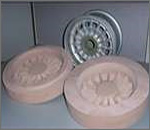Introduction: A pattern is a shaped form of wood or metal around which sand is packed in the mold. When the pattern is removed the resulting cavity is the exact shape of the object to be cast. The pattern must be designed to be easily removed without damage to the mold. It must be accurately dimensioned and durable enough for the use intended. Either one time use or productio

n runs.
Process: Each different item we wish to cast presents unique problems and requirements. In a large foundry there is a close relationship between the pattern maker and the molder. Each is aware of the capabilities and limitations of his own field.
Throughout the industry, pattern making is a field and an art of it's own. The pattern maker is not a molder nor the molder a pattern maker. This is not to imply that the pattern maker cannot make a simple mold or the molder make a simple pattern but each may soon reach a point in the other's field beyond his own skill and experience.
In the hobby or one man shop, however, pattern and mold making are so closely interrelated as to become almost one continuous operation. This chapter will acquaint you with some of the various types of patterns and their requirements.
Materials used for Pattern making: Wood, metal, rubber, plaster and wax are commonly used to make patterns. polystyrene based material, suited to produce complex investment casting patterns. The sintered patterns are enough porous in order to allow the convenient wax infiltration, and therefore becoming easy to handle and to finish. Polystyrene patterns can undergo the typical rapid casting procedure, including autoclaves and flash firing steps, low-temperature furnaces and vacuum plaster casting methods.
The pattern can be made of any material like clay, wood, and wax. The pattern material really depends on a few factors like the casting method and the availability of the material. If you are able to carve wood then you can use this skill to make patterns. There are some casting methods that call for the patterns to be made of certain materials. An example of this is the Lost Wax Casting Method which will use wax as the pattern.
Application: Common pattern castings include complex engine parts for models, replicas of Civil War era weapons, sculptures, and even jewelry. In todays hi-tech environ casting is done for safety pins to space crafts.


